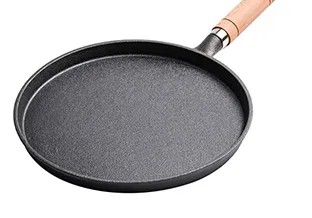
enamel cast iron vs cast iron
Enamel Cast Iron vs. Cast Iron Understanding the Differences
Cast iron cookware has enjoyed a long-standing reputation in kitchens worldwide, celebrated for its durability, excellent heat retention, and natural non-stick properties when seasoned correctly. However, in recent years, enamel-coated cast iron has emerged as a popular alternative, appealing to both amateur and professional chefs alike. Understanding the key differences between traditional cast iron and enamel cast iron can help consumers make informed decisions about which type best suits their cooking needs.
Composition and Construction
Traditional cast iron is made from a blend of iron, carbon, and silicon. This combination gives it its characteristic strength and ability to withstand high temperatures. The cookware is thick and heavy, allowing it to retain heat effectively, which is beneficial for slow cooking and achieving perfect browning on meats.
Enamel cast iron, on the other hand, is coated with a layer of enamel glaze. This enamel is typically made from glass and various minerals, which are fused to the metal during the manufacturing process at high temperatures. The resulting cookware comes in various colors and provides an aesthetic appeal that complements modern kitchen styles. The enamel layer serves several purposes it protects the iron from rust, makes it easier to clean, and allows the cookware to be used with acidic ingredients without fear of reaction.
Ease of Use and Maintenance
One of the standout benefits of enamel cast iron is its ease of maintenance. Unlike traditional cast iron, which requires regular seasoning and careful handling to prevent rust and maintain its non-stick surface, enamel-coated pans are generally dishwasher-safe and do not need seasoning. This makes them particularly appealing to novice cooks who may not be familiar with the maintenance required for traditional cast iron.
Moreover, enamel cast iron cookware is less reactive with acidic foods, such as tomatoes or citrus-based dishes
. Traditional cast iron can impart metallic flavors to such dishes if not well-seasoned, whereas the enamel coating acts as a barrier, ensuring that the flavors remain true and untainted.enamel cast iron vs cast iron

Performance Differences
While both types of cookware perform exceptionally well for various cooking applications, they do have distinct differences in performance. Traditional cast iron is unparalleled for high-heat cooking applications like searing and frying. The ability of cast iron to maintain high temperatures without dropping significantly is unmatched, making it ideal for both stovetop and oven use. However, extreme heat can damage the enamel on enamel cast iron, making it less suitable for broiling or other high-heat cooking methods.
Enamel cast iron, however, excels in its ability to maintain even cooking temperatures due to its smooth surface and heat retention qualities. This makes it a favorite for slow-cooked dishes, stews, and braised meats, where consistent heat is crucial for tender, flavorful results.
Color and Aesthetic Appeal
Another area where enamel cast iron excels is in customization. Available in a variety of colors, enamel cookware allows home cooks to express their personal style in the kitchen. From vibrant reds and blues to subdued whites and blacks, there is an option to suit any aesthetic. In contrast, traditional cast iron is typically left in its natural, rustic finish or seasoned to achieve a dark, shiny patina, which may not appeal to everyone.
Price Point and Investment
When it comes to cost, enamel cast iron can be more expensive than its uncoated counterpart due to the additional manufacturing processes involved in applying the enamel layer. However, many consider this investment worthwhile given the aesthetic appeal, ease of cleaning, and versatility that enamel cast iron offers.
In conclusion, both enamel cast iron and traditional cast iron cookware have their own merits and applications, catering to different cooking styles and preferences. For chefs who prioritize high-heat cooking and traditional methods, classic cast iron remains an indispensable tool. Conversely, those looking for ease of use and a vibrant addition to their kitchen may find enamel cast iron better suited to their needs. Ultimately, the choice between enamel cast iron and cast iron lies in personal preferences and cooking habits, each offering a unique set of benefits that can enhance culinary experiences in the kitchen.
-
Season Cast Iron Perfectly with GPT-4 Turbo TipsNewsAug.01,2025
-
High Quality Cast Iron Cookware - Baixiang County Zhongda MachineryNewsAug.01,2025
-
Premium Cast Iron Pan: Durable & Perfect HeatNewsAug.01,2025
-
High Quality Kitchen Durable Black Round Cast Iron Cookware Pancake Crepe Pan-Baixiang County Zhongda Machinery Manufacturing Co., Ltd.NewsAug.01,2025
-
Cast Iron Cookware - Baixiang County Zhongda Machinery | Nonstick, Heat ResistanceNewsAug.01,2025
-
High Quality Kitchen Durable Black Round Cast Iron Cookware - Baixiang County Zhongda Machinery | Non-Stick, Heat Retention, DurableNewsJul.31,2025


